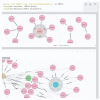Information Management in Healthcare and Environment: Towards an Automatic System for Fake News Detection
- PMID: 32046238
- PMCID: PMC7037767
- DOI: 10.3390/ijerph17031066
Information Management in Healthcare and Environment: Towards an Automatic System for Fake News Detection
Abstract
Comments and information appearing on the internet and on different social media sway opinion concerning potential remedies for diagnosing and curing diseases. In many cases, this has an impact on citizens' health and affects medical professionals, who find themselves having to defend their diagnoses as well as the treatments they propose against ill-informed patients. The propagation of these opinions follows the same pattern as the dissemination of fake news about other important topics, such as the environment, via social media networks, which we use as a testing ground for checking our procedure. In this article, we present an algorithm to analyse the behaviour of users of Twitter, the most important social network with respect to this issue, as well as a dynamic knowledge graph construction method based on information gathered from Twitter and other open data sources such as web pages. To show our methodology, we present a concrete example of how the associated graph structure of the tweets related to World Environment Day 2019 is used to develop a heuristic analysis of the validity of the information. The proposed analytical scheme is based on the interaction between the computer tool-a database implemented with Neo4j-and the analyst, who must ask the right questions to the tool, allowing to follow the line of any doubtful data. We also show how this method can be used. We also present some methodological guidelines on how our system could allow, in the future, an automation of the procedures for the construction of an autonomous algorithm for the detection of false news on the internet related to health.
Keywords: environment; fake news; graph; healthcare; reinforcement learning.
Conflict of interest statement
The authors declare no conflict of interest.
Figures








References
-
- Los ministerios de Sanidad y Ciencia realizan un primer listado de 73 pseudoterapias. [(accessed on 17 December 2019)]; Available online: http://www.rtve.es/noticias/20190228/ministerios-sanidad-ciencia-realiza....
-
- Psoriasis, lupus, alergia… Enfermedades autoinmunes crónicas, o no? [(accessed on 19 December 2019)]; Available online: https://tunaturopata.es/psoriasis-lupus-autoinmune-tratamiento-natural/
-
- Musso M., Pinna R., Melis G., Carrus P.P. How Social Media Platform can Support Value Cocreation Activities in Healthcare. Excellence in Services; Proceedings of the EISIC-Excellence in Services International Conference 2018; Paris, France. 30–31 August 2018; pp. 535–555.
-
- Kumar R., Novak J., Tomkins A. Link Mining: Models, Algorithms, and Applications. Springer; New York, NY, USA: 2010. Structure and evolution of online social networks; pp. 337–357.
Publication types
MeSH terms
LinkOut - more resources
Full Text Sources
Medical

